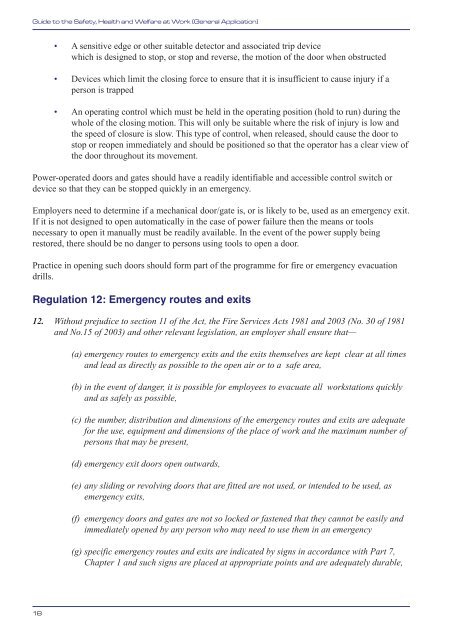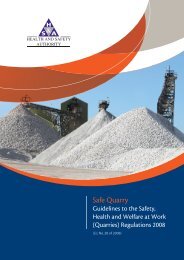Guide to the Safety, Health and Welfare at Work (General Application)
Guide to the Safety, Health and Welfare at Work (General Application)
Guide to the Safety, Health and Welfare at Work (General Application)
Create successful ePaper yourself
Turn your PDF publications into a flip-book with our unique Google optimized e-Paper software.
<strong>Guide</strong> <strong>to</strong> <strong>the</strong> <strong>Safety</strong>, <strong>Health</strong> <strong>and</strong> <strong>Welfare</strong> <strong>at</strong> <strong>Work</strong> (<strong>General</strong> Applic<strong>at</strong>ion)<br />
• A sensitive edge or o<strong>the</strong>r suitable detec<strong>to</strong>r <strong>and</strong> associ<strong>at</strong>ed trip device<br />
which is designed <strong>to</strong> s<strong>to</strong>p, or s<strong>to</strong>p <strong>and</strong> reverse, <strong>the</strong> motion of <strong>the</strong> door when obstructed<br />
• Devices which limit <strong>the</strong> closing force <strong>to</strong> ensure th<strong>at</strong> it is insufficient <strong>to</strong> cause injury if a<br />
person is trapped<br />
• An oper<strong>at</strong>ing control which must be held in <strong>the</strong> oper<strong>at</strong>ing position (hold <strong>to</strong> run) during <strong>the</strong><br />
whole of <strong>the</strong> closing motion. This will only be suitable where <strong>the</strong> risk of injury is low <strong>and</strong><br />
<strong>the</strong> speed of closure is slow. This type of control, when released, should cause <strong>the</strong> door <strong>to</strong><br />
s<strong>to</strong>p or reopen immedi<strong>at</strong>ely <strong>and</strong> should be positioned so th<strong>at</strong> <strong>the</strong> opera<strong>to</strong>r has a clear view of<br />
<strong>the</strong> door throughout its movement.<br />
Power-oper<strong>at</strong>ed doors <strong>and</strong> g<strong>at</strong>es should have a readily identifiable <strong>and</strong> accessible control switch or<br />
device so th<strong>at</strong> <strong>the</strong>y can be s<strong>to</strong>pped quickly in an emergency.<br />
Employers need <strong>to</strong> determine if a mechanical door/g<strong>at</strong>e is, or is likely <strong>to</strong> be, used as an emergency exit.<br />
If it is not designed <strong>to</strong> open au<strong>to</strong>m<strong>at</strong>ically in <strong>the</strong> case of power failure <strong>the</strong>n <strong>the</strong> means or <strong>to</strong>ols<br />
necessary <strong>to</strong> open it manually must be readily available. In <strong>the</strong> event of <strong>the</strong> power supply being<br />
res<strong>to</strong>red, <strong>the</strong>re should be no danger <strong>to</strong> persons using <strong>to</strong>ols <strong>to</strong> open a door.<br />
Practice in opening such doors should form part of <strong>the</strong> programme for fire or emergency evacu<strong>at</strong>ion<br />
drills.<br />
Regul<strong>at</strong>ion 12: Emergency routes <strong>and</strong> exits<br />
12. Without prejudice <strong>to</strong> section 11 of <strong>the</strong> Act, <strong>the</strong> Fire Services Acts 1981 <strong>and</strong> 2003 (No. 30 of 1981<br />
<strong>and</strong> No.15 of 2003) <strong>and</strong> o<strong>the</strong>r relevant legisl<strong>at</strong>ion, an employer shall ensure th<strong>at</strong>—<br />
(a) emergency routes <strong>to</strong> emergency exits <strong>and</strong> <strong>the</strong> exits <strong>the</strong>mselves are kept clear <strong>at</strong> all times<br />
<strong>and</strong> lead as directly as possible <strong>to</strong> <strong>the</strong> open air or <strong>to</strong> a safe area,<br />
(b) in <strong>the</strong> event of danger, it is possible for employees <strong>to</strong> evacu<strong>at</strong>e all workst<strong>at</strong>ions quickly<br />
<strong>and</strong> as safely as possible,<br />
(c) <strong>the</strong> number, distribution <strong>and</strong> dimensions of <strong>the</strong> emergency routes <strong>and</strong> exits are adequ<strong>at</strong>e<br />
for <strong>the</strong> use, equipment <strong>and</strong> dimensions of <strong>the</strong> place of work <strong>and</strong> <strong>the</strong> maximum number of<br />
persons th<strong>at</strong> may be present,<br />
(d) emergency exit doors open outwards,<br />
(e) any sliding or revolving doors th<strong>at</strong> are fitted are not used, or intended <strong>to</strong> be used, as<br />
emergency exits,<br />
(f) emergency doors <strong>and</strong> g<strong>at</strong>es are not so locked or fastened th<strong>at</strong> <strong>the</strong>y cannot be easily <strong>and</strong><br />
immedi<strong>at</strong>ely opened by any person who may need <strong>to</strong> use <strong>the</strong>m in an emergency<br />
(g) specific emergency routes <strong>and</strong> exits are indic<strong>at</strong>ed by signs in accordance with Part 7,<br />
Chapter 1 <strong>and</strong> such signs are placed <strong>at</strong> appropri<strong>at</strong>e points <strong>and</strong> are adequ<strong>at</strong>ely durable,<br />
18

















